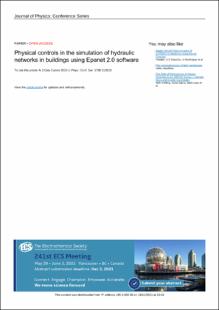Mostrar el registro sencillo del ítem
Physical controls in the simulation of hydraulic networks in buildings using Epanet 2.0 software
| dc.contributor.author | calixto, nelson javier | |
| dc.date.accessioned | 2021-11-19T13:46:29Z | |
| dc.date.available | 2021-11-19T13:46:29Z | |
| dc.date.issued | 2020-12-05 | |
| dc.identifier.uri | http://repositorio.ufps.edu.co/handle/ufps/1128 | |
| dc.description.abstract | Water supply and distribution are an important design criterion in building construction. For this it is necessary to make an analysis of hydraulic networks, which is generally done through conventional methods based on iterative processes in spreadsheets. However, the Epanet 2.0 software can serve as an analysis method through simulation that is not currently considered for these applications, while such software is not a conventional method, it holds the possibility of being a model which through physical controls can serve as a simulator for hydraulic networks with the hypothesis that it can optimize costs and solution times. Therefore, the research has as purpose the application of physical controls for the analysis of the hydraulic networks in buildings by means of the software. For this reason, a design of the hydraulic network calculated by the modified Hunter model was executed and compared with the simulation in the software. The results obtained from the study demonstrated effectiveness of the software with a minimum percentage of error (0.24% to 1.06%) from one method to another, achieving to optimize calculation times and the economy of designs. | eng |
| dc.format.extent | 07 páginas | spa |
| dc.format.mimetype | application/pdf | spa |
| dc.language.iso | eng | spa |
| dc.publisher | Journal of Physics: Conference Series | spa |
| dc.relation.ispartof | Journal of Physics: Conference Series | |
| dc.rights | © Copyright 2021 IOP Publishing | eng |
| dc.source | https://iopscience.iop.org/article/10.1088/1742-6596/1708/1/012028/meta | spa |
| dc.title | Physical controls in the simulation of hydraulic networks in buildings using Epanet 2.0 software | eng |
| dc.type | Artículo de revista | spa |
| dcterms.references | Muhammat K and Fatah A 2020 Analysis of availability and water demand: a case study in Sumberejo Village Tanggamus regency IOP Conf. Ser. Mater. Sci. Eng. 807 012020:1 | spa |
| dcterms.references | Duan X, Zong Y, Hao K, Huang D and Li Y 2019 Research of hydraulic reliability of water supply network based on the simulation of EPANET IOP Conf. Ser.: Earth Environ. Sci. 349 012042:1 | spa |
| dcterms.references | Study C, Tirta P and Safitri A 2020 Simulation of transmission of drinking water sources to reservoirs: simulation of transmission of drinking water sources to reservoirs: case study PDAM Tirta Jati, Cirebon, Indonesia IOP Conf. Ser. Earth Environ. Sci. 478 012072:1 | spa |
| dcterms.references | Garzón Orduña A 2014 Evaluación Patrones de Consumo y Caudales Máximos Instantáneos de Usuarios Residenciales de la Ciudad de Bogotá (Bogotá: Universidad Nacional de Colombia) | spa |
| dcterms.references | De Plaza S 2017 Ejercicios Básicos de Mecánica de Fluidos e Hidráulica Aplicados a través del Software de Distribución Gratuita EPANET 2.0 (Bogotá: Universidad Piloto de Colombia) | spa |
| dcterms.references | Instituto Colombiano de Normas Técnicas y Certificación (ICONTEC) 2017 Código Colombiano de Instalaciones Hidráulicas y Sanitarias, NTC 1500 (Colombia: Instituto Colombiano de Normas Técnicas y Certificación) | spa |
| dcterms.references | Cheung P B, Van Zyl J E and Ribeiro Reis L F 2005 Eight International Conference on Computing and Control in the Water Industry CCWI05 ‘Water Management for the 21st Century (Exeter: Centre for Water Systems) Extension of EPANET for pressure driven demand modeling in water distribution system | spa |
| dcterms.references | Renán Z 2013 Evaluación de los Métodos para el Cálculo de Caudales Máximos Probables Instantáneos en Edificaciones (Cartago: Instituto Tecnológico de Costa Rica) | spa |
| dcterms.references | Godoy A A and Cifuentes C G 2018 Mejoramiento de la Red de Distribución del Sistema de Acueducto AUACACT en la Localidad de Ciudad Bolivar Mediante Modelación en EPANET - BOGOTA D.C. (Bogotá: Universidad Católica de Colombia) | spa |
| dcterms.references | Suchorab P and Iwanek M 2019 Water losses analysis based on FEFLOW FEM simulation and EPANET hydraulic modelling IOP Conf. Ser. Mater. Sci. Eng. 710 012002 | spa |
| dcterms.references | García Alcaraz M and del M 2006 Modelación y Simulación de Redes Hidráulicas a Presión Mediante Herramientas Informáticas (Madrid: Universidad Politécnica de Cartagena) | spa |
| dcterms.references | Noriega Saltarín C and Ahumada Arenas M J 2006 Desarrollo de una interfaz automatizada para el análisis hidráulico de redes de tubería en Solid Edge Prospectiva 4 51 | spa |
| dcterms.references | Morelos R and Hernández R 2017 Modelación hidráulica de la red de distribución de agua potable en una ciudad Mexicana EPANET Revista Iberoamericana de Ciencias 4 120 | spa |
| dc.identifier.doi | https://doi.org/10.1088/1742-6596/1708/1/012028 | |
| dc.publisher.place | Reino Unido | spa |
| dc.relation.citationedition | Vol.1708 No.1.(2020) | spa |
| dc.relation.citationendpage | 7 | spa |
| dc.relation.citationissue | 1(2020) | spa |
| dc.relation.citationstartpage | 1 | spa |
| dc.relation.citationvolume | 1708 | spa |
| dc.relation.cites | Cely-Calixto, N. J. (2020, December). Physical controls in the simulation of hydraulic networks in buildings using Epanet 2.0 software. In Journal of Physics: Conference Series (Vol. 1708, No. 1, p. 012028). IOP Publishing. | |
| dc.relation.ispartofjournal | Journal of Physics: Conference Series | spa |
| dc.rights.accessrights | info:eu-repo/semantics/openAccess | spa |
| dc.rights.creativecommons | Atribución 4.0 Internacional (CC BY 4.0) | spa |
| dc.type.coar | http://purl.org/coar/resource_type/c_6501 | spa |
| dc.type.content | Text | spa |
| dc.type.driver | info:eu-repo/semantics/article | spa |
| dc.type.redcol | http://purl.org/redcol/resource_type/ART | spa |
| oaire.accessrights | http://purl.org/coar/access_right/c_abf2 | spa |
| oaire.version | http://purl.org/coar/version/c_970fb48d4fbd8a85 | spa |
| dc.type.version | info:eu-repo/semantics/publishedVersion | spa |










